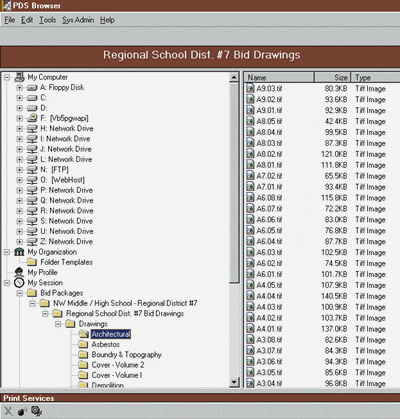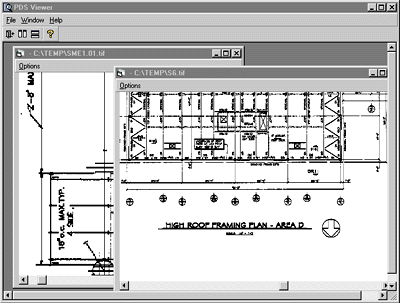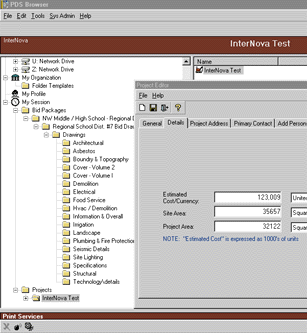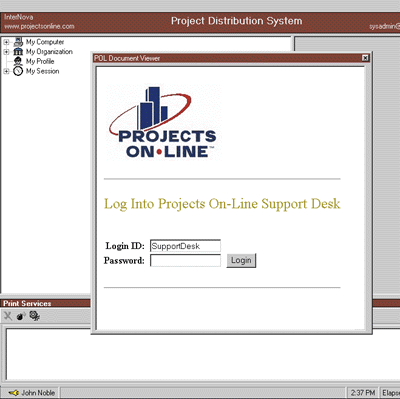![]()
|
This article may contain URLs that were valid when originally published, but now link to sites or pages that no longer exist. To maintain the flow of the article, we've left these URLs in the text, but disabled the links.
|
|
Developing a Subscription-Based Extranet
Raghuram Bala |
| In the real world, sometimes it pays to leave traces of DNA everywhere. Windows DNA makes it easy to tie together disparate parts of a corporate solution while providing a consistent interface for users and developers. |
|
There has been a lot of talk about how the Internet will reshape the way you work, the way you think, and the way enterprises conduct their day-to-day business activities. This case study focuses on an Internet-based application called the Project Distribution System (PDS) that is revolutionizing the way building construction projects are designed, developed, and managed in the architectural/engineering/construction (AEC) industry.
The AEC industry has long sought an easier way for disparate entities participating in building construction projects to collaborate. A construction project may involve architects, civil engineers, surveyors, estimators, building contractors, the local zoning commission, and many other entities. Often, pulling these different factions together and getting a project completed has been difficult, especially on larger assignments. Project delays and budget overruns are epidemic in the construction industry; some of these could be easily eliminated by improved communications. PDS is a subscription-based extranet, developed by Projects-OnLine/InterNova, that enables construction projects to be accessed efficiently and securely over the Internet. Project participants can collaborate without the hassles of phone calls, faxes, or snail-mail; it's estimated to reduce costs by about 30 percent. PDS also allows subscribers to review Request For Proposals (bid packages) on upcoming projects nationwide, which needless to say offers subscribers a tremendous opportunity to increase revenues. One of the daily routines of architects and engineers is the printing of large-scale blueprints, which require specialized printers and plotters. In the past, users have had to submit print jobs to printing houses by physically driving over or sending documents by snail-mail—a slow and time-consuming process. With PDS, users can submit print jobs to the nationwide ReproCad network of print shops and have their documents delivered to their doorstep via UPS or FedEx—a vast improvement. Application Features One of the key goals in constructing PDS was to build a highly graphical application that used concepts and metaphors familiar to business users.
|
 |
| Figure 1: The PDS Interface |
|
With a user base familiar with Windows, the design team felt that using a Windows Explorer-like interface was a good choice (see Figure 1). The PDS application extends the
Explorer paradigm by providing a seamless environment between the local network and the remote system. The remote system manifests itself
as special folders called My Organization, My Profile, and My Session. The local system is called My Computer, containing all of the local and network drives.
The entire PDS system focuses on the concept of folders and objects. Every object in PDS belongs to a class, and a class is an abstract data type consisting of attributes and functions (or methods). One such attribute is the viewer or editor of a class. For most document objects, PDS comes fitted with an ActiveX® viewer application capable of viewing 150 different document formats including Microsoft Excel and Word, GIF, JPEG, all AutoCad formats, HTML, and PDF. The PDS Viewer is an ActiveX server that uses an MDI window. It's capable of panning, zooming, and manipulating drawings as well as red-lining and annotating (for high-end users at additional cost). The PDS Viewer also allows documents to stay in their native format without conversions to preserve their attributes (see Figure 2). |
 |
| Figure 2: PDS Viewer |
| Business classes also have editors. One such editor is the Project Editor, a key part of PDS. Figure 3 shows the Project Editor, where privileged users can manipulate the attributes of a given project. Owing to its object-oriented roots, PDS makes it easy to accommodate additional classes without requiring modifications to the client application. |
 |
| Figure 3: PDS Project Editor |
|
A major concern of any mission-critical business application is security. Besides the fundamental security provisions such as packet filtering, firewalls, virus protection, and Secure Sockets Layer (SSL), this system includes a comprehensive set of object privileges. Privileges on objects can be granted to individuals or groups, similar to the system used by many file systems. Privileges can also be granted to classes of objects instead of individual objects.
Drag and drop capabilities were added to PDS as well. Users can drag and drop files from their local environment to the remote system. PDS will upload the files to the destination folder, provided the user has sufficient privileges. Drag and drop makes ordering print jobs extremely easy. Users can submit orders to ReproCad print shops by simply dragging and dropping files to the Print Services tray. Users can then select from a variety of different print options such as binding, laminating, and so on for each order. Orders and documents are zipped up and shipped off to the print shop of the user's choosing (see Figure 4). |
 |
| Figure 4: Prnting PDS Projects |
|
PDS also includes the Microsoft WebBrowser control that allows users to access Web resources within business applications. The WebBrowser control is used to submit user feedback and customer service queries to an online helpdesk system, as shown in Figure 5. |
 |
| Figure 5: PDS Uses the WebBrowser Control |
|
Architecture Overview The PDS infrastructure is based on the Microsoft Windows DNA architecture. PDS uses a multitier architecture: presentation tier, application services tier, and database tier (see Figure 6). |
 |
| Figure 6: The PDS Architecture |
This architecture has the following advantages:
Complementing this architecture is a supporting cast of high-end servers, round-the-clock backup systems, uninterruptable power supplies and generators, tech support, and a staff of trained technicians. Let's take a closer look at each facet of the system. Presentation Tier The presentation tier houses the client application developed in Visual
Basic® 5.0. The client is a standalone ActiveX server application, not an Active Document housed within Microsoft Internet Explorer. This allows greater flexibility and consumes less memory without having to run within the browser's memory space. Some limitations of user documents, such as the inability to open nonmodal windows, is also removed. The PDS Viewer is a separate ActiveX server application.
|
 |
| Figure 9: Invoking Remote Objects |
|
One of the primary functions of PDS is to facilitate sharing of documents; constant uploading and downloading of data consumes bandwidth and slows down the user. To combat this to some degree, PDS has its own caching scheme, which saves download time. When a document is viewed for the first time, it is downloaded to the user's hard drive; on subsequent occasions the locally cached copy is read unless the user requests to download a new copy.
Application Services Tier For scalability, the PDS system was partitioned into a number of different services in the form of ActiveX DLLs running within the process space of Microsoft Transaction Server (MTS). Business logic is housed on the application services tier, utilizing Microsoft Internet Information Server (IIS) 4.0 and MTS 2.0. Business logic in PDS has been grouped into services such as Administration, Order, System, File, Zip, Membership, Message, Print, and Project. Each of these services is an ActiveX DLL housing a number of business classes. Each class carries out a distinct business function and interacts with one or more tables on the database.
|
|
|
Using the handle that is returned, one machine can update another machine's registry entries using other registry API functions like RegCreateKeyEx and RegDeleteKey.
Database Tier The database tier utilizes SQL Server™ 6.5, although migration to SQL Server 7.0 is imminent. PDS employs a distributed database architecture consisting of two types of databases. The system databases manage core functionality such as membership and administration data. The project databases hold project information, references to documents, and store business objects as well as privileges within the project. This architecture enables easy offlining of dormant projects and simplifies the management of the system. The multidatabase architecture used by PDS is similar to that
of the Unix file system, where external file systems can
be mounted and dismounted at mount points.
|
|
|
lets you concatenate several varchar or char or text strings.
Conclusion PDS demonstrates the completeness of the Microsoft suite of tools and technologies for developing scalable, distributed business applications. PDS is also a clear statement of how the Internet can be used effectively to build business systems without employing a Web interface. Above all, PDS is a true e-business, providing users with a compelling need to use the Internet to save time and money.
|
 |
|
http://msdn.microsoft.com/xml/scenario/texcel.asp
http://msdn.microsoft.com/workshop/components/offline/offline.asp |
From the February 1999 issue of Microsoft Internet Developer.